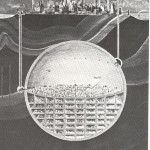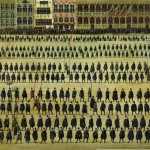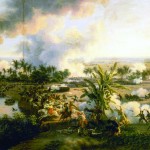Some time ago we posted an interesting 1975 map entitled “Removal of Manhattan Island“, by Robert Grosvenor. The operation (see below) of disposing of an entire land in order to relocate it was to be intended as a conceptual operation aimed at the eventual reclamation of the territory:
1975 Removal of Manhattan Island [Robert Grosvenor]
Author text:
“The first of a series of projects dealing with:
1.The Removal of Manhattan
2.Trials to test the seaworthiness of the island
3.The reclamation of the island”

Many years before the exact opposite of that, (not in terms of ambitions), was proposed by Dr.T. Kenard Thomson.
Well established consulting engineer and urban planner for the City of New York, Dr. T.Kenard Thomson proposed in 1916 an utopian project for the addition of 50 square miles of land to the metropolitan area of Manhattan, through an article in Popular Science, in which he advocated ‘A Really Greater New York’.
Some excerpts of it I found on a wide article on Think Big:
The continuous expansion of the city was generating enormous strains: “New York’s overflow has made of Brooklyn a great city. New subways are constantly being built, yet are inadequate when they are completed. Twenty-five years ago New Yorkers felt sure that their water-front would be sufficient for their purposes for many years. Today engineers are searching for some method to cut the knot of New York’s harbor congestion problems.”
Hence Dr Thomson’s radical, but ultimately indispensible plan: “I propose to add, by a series of engineering projects, fifty square miles to Greater New York’s area and port foothold. At the same time this will mean an addition of one hundred miles of new water-front. New York’s City Hall would become the center of a really greater New York, having a radius of twenty-five miles, and within that circle there would be ample room for a population of twenty-five millions, the entire project to be carried out within a few years. Many have said ‘It can’t be done.’ The majority of engineers, however, have acknowledged the possibility, and I have received hundreds of letters of encouragement.”



As an engineer Dr. Thomson worked on 20 skyscrapers, and designed and built numerous pneumatic caissons. Thomson oversaw the installation of the caissons below the Mutual Life Building in lower Manhattan. That building, designed by architects Clinton and Russell (Hotel Breslin, The Apthorp, 60 Wall St., Astor Hotel, Beaver – Cocoa Exchange – Building and many other notable buildings) was unfortunately demolished. These photos document the creations of the caissons below the Mutual Life Building:




Related: some years later, in 1934, an article on Modern Mechanix appeared, proposing to fill the Hudson river in order to expand the surface of the city: “Filling in the Hudson to Rebuild New York” (Mar, 1934). Here you can find higher def scans.





Via: Colt+Rane





Leave a Reply